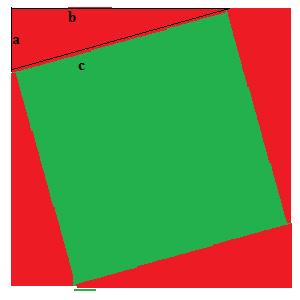Pythagoras theorem, that the square of the longest side of a right angled triangle is equal to the sum of the squares of the other 2 sides.

This can be proved quite easily by drawing a square into which fit 4 of the same right angled triangle as shown below
As you can see the area of the whole square is equal to the the sum of the 2 shorter sides squared or (a+b)2. The area of the green square left is the square of the longest side c2. We also know that the area of each of the triangles is 1/2 x base x height = ab/2
From these 3 areas we can prove the theorem. The know that the total area of the square is equal to the area of the green square plus 4 of the triangles ie)
(a+b)2=c2+ 4ab/2
a2 + b2 + 2ab = c2+ 2ab
The 2ab ’s cancel and we are left with Pythagoras theorem
a2 + b2 = c2
View the rest of my posts on this blog or at my website



No comments:
Post a Comment
Please comment if any information is incorrect, could be expanded or you have a question about it.